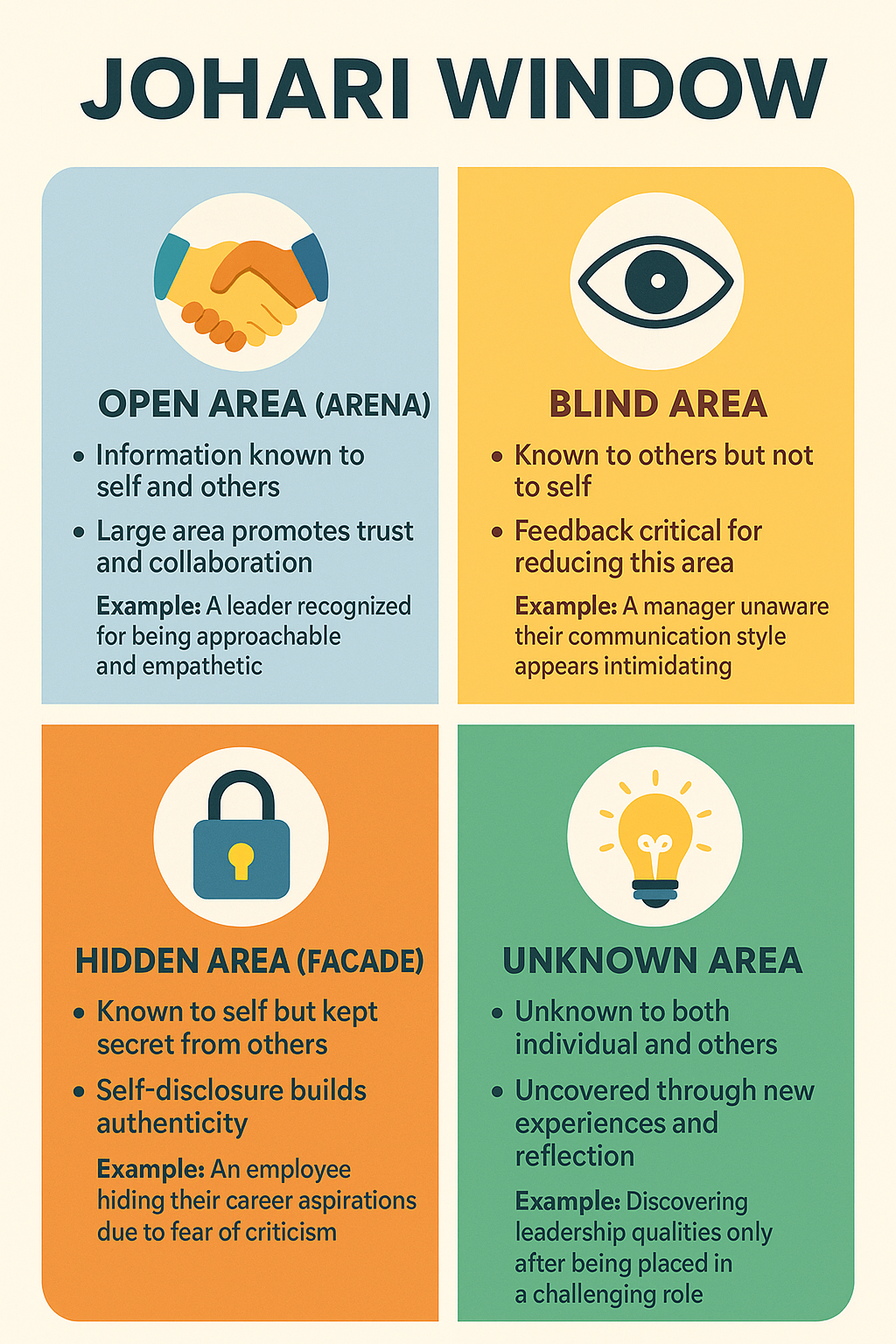2 Understanding Self and Others through Johari Window
Self-awareness and interpersonal effectiveness are deeply interconnected. While the journey of self-discovery emphasizes the inner exploration of personality, values, and strengths, understanding others requires feedback, dialogue, and trust.
The Johari Window, developed by Joseph Luft & Harry Ingham (1961), is one of the most influential models for exploring this dual process.
The Johari Window is widely applied in leadership development, team building, counseling, and organizational communication. It demonstrates how individuals can expand their understanding of self while simultaneously deepening mutual trust with others. In essence, the model highlights that personal effectiveness is incomplete without the ability to appreciate how one is perceived in social and professional contexts.
Open Area
(Known to Self & Known to Others)
Blind Area
(Unknown to Self, Known to Others)
Hidden Area
(Known to Self, Unknown to Others)
Unknown Area
(Unknown to Self & Others)

2.1 The Johari Window Framework
Johari Window
Represents information known both to the self and to others.
Includes behaviors, attitudes, skills, and communication patterns openly acknowledged.
A large open area promotes trust, collaboration, and transparency.
Example: A leader who is openly recognized for being approachable and empathetic.
Known to others but not to the self.
Reflects blind spots that may limit personal effectiveness.
Feedback is critical for reducing this area.
Example: A manager unaware that their communication style appears intimidating.
Known to self but kept secret from others.
May include personal fears, insecurities, or unspoken values.
Reducing this area through selective self-disclosure builds authenticity.
Example: An employee hiding their career aspirations due to fear of criticism.
Unknown to both the individual and others.
Represents latent talents, subconscious motives, or unexplored potential.
Can be uncovered through new experiences, reflection, and coaching.
Example: Discovering leadership qualities only after being placed in a challenging role.
2.2 Dynamics of the Johari Window
Self-Disclosure
The process of sharing information about oneself with others to expand the open area and reduce the hidden area. Effective leaders selectively disclose values, beliefs, and experiences to foster trust.
Feedback
Receiving constructive observations from others to reduce the blind area. Feedback mechanisms such as 360-degree reviews are essential in organizations.
Discovery and Learning
New experiences, reflection, and mentoring reduce the unknown area by surfacing hidden abilities and aspirations.
2.3 Managerial Applications
Enhancing Teamwork
Teams with larger open areas communicate more effectively, resolve conflicts faster, and demonstrate stronger collaboration.
Building Trust
Self-disclosure in appropriate contexts reduces misunderstandings and strengthens psychological safety within organizations.
Leadership Development
By reducing blind spots through feedback, leaders become more authentic and responsive, aligning with Goleman’s concept of emotional intelligence.
Conflict Resolution
Understanding perceptions reduces misinterpretations and prevents escalation of conflicts.
2.4 Tools and Practices to Apply Johari Window
Feedback Mechanisms
- 360-degree feedback systems
- Peer reviews and mentoring programs
- Informal check-ins with colleagues
Self-Disclosure Strategies
- Sharing personal values and motivations during team interactions
- Practicing vulnerability in leadership conversations
- Using storytelling to connect with teams
Experiential Learning
- Rotational assignments to uncover hidden talents
- Simulation exercises and role plays to reveal latent strengths
2.5 Indian and Global Perspectives
Indian Perspective
In the Indian cultural context, openness may sometimes be constrained by hierarchical norms and power distance. However, organizations like Infosys and Tata Group have embraced reflective practices, feedback cultures, and leadership training to encourage greater transparency and trust.
Global Perspective
In Western cultures, especially in flat organizational structures, feedback and self-disclosure are emphasized more directly. Companies like Google and Microsoft integrate feedback loops into performance management, thereby continuously reducing blind and hidden areas.
2.6 Case Studies
Case Study 1: Indian Context – Infosys Leadership Institute
Infosys uses feedback-rich training and coaching models where leaders are encouraged to reflect on blind spots and share personal stories. This application of Johari principles has contributed to a culture of openness and ethical leadership.
Case Study 2: Global Context – Google’s Project Aristotle
Google’s study on team effectiveness revealed that psychological safety was the most important factor in high-performing teams. Teams with larger “open areas” and reduced blind spots performed better, validating the Johari Window’s principles in a modern organizational setting.
2.7 Challenges in Applying the Johari Window
- Cultural Barriers: In high-context or hierarchical cultures, disclosure and feedback may be limited.
- Fear of Vulnerability: Employees may hesitate to share weaknesses.
- Resistance to Feedback: Defensive attitudes can prevent reduction of blind areas.
- Over-Disclosure: Sharing too much personal information may reduce professionalism.
2.8 Advantages of Johari Window Application
- Improves communication and reduces misunderstandings.
- Builds empathy and emotional intelligence.
- Enhances leadership authenticity and credibility.
- Strengthens team cohesion and trust.
- Encourages continuous learning and self-improvement.
2.9 Summary
The Johari Window provides a powerful framework for understanding the self in relation to others. By balancing self-disclosure and feedback, individuals expand their open area, reduce blind spots, and uncover hidden potential. For managers and leaders, it is not just a psychological tool but a practical framework to build trust, enhance collaboration, and foster authentic leadership.
Indian and global experiences highlight its universal applicability, though cultural adaptations are necessary. Ultimately, the Johari Window demonstrates that personal effectiveness and self-leadership are incomplete without a reciprocal process of learning from others and sharing oneself authentically.